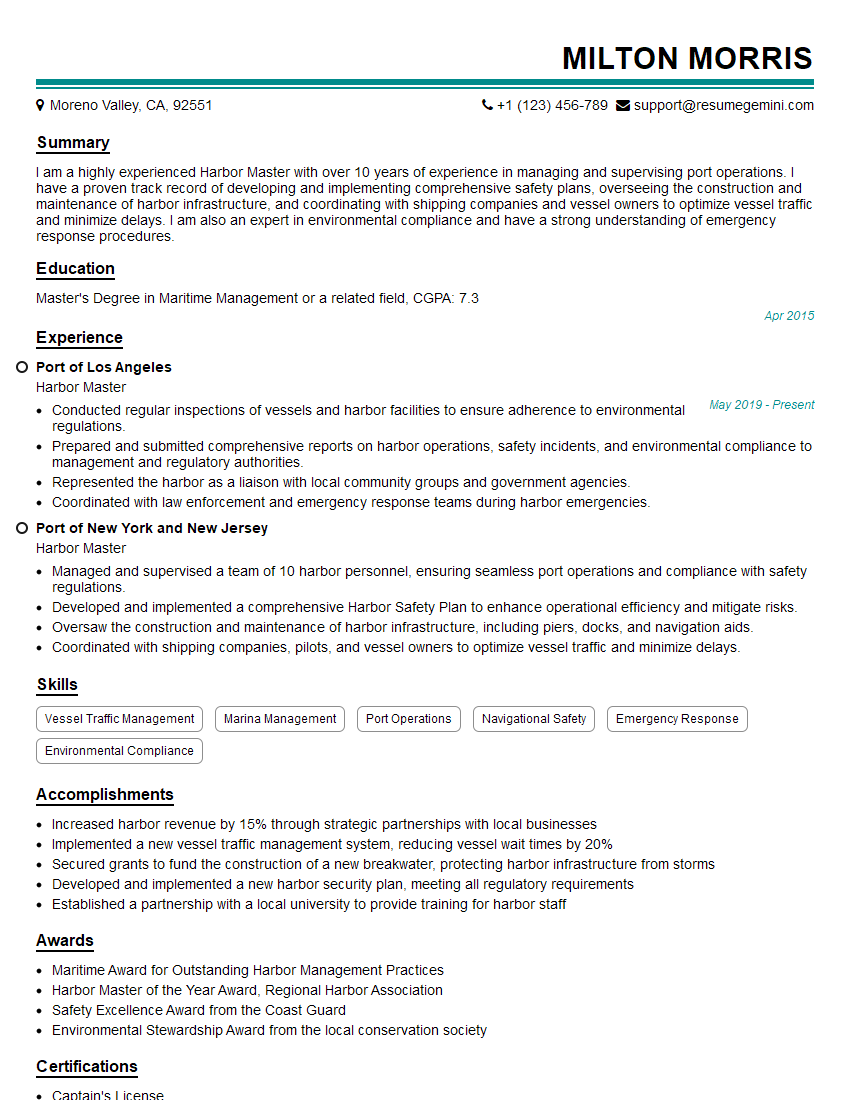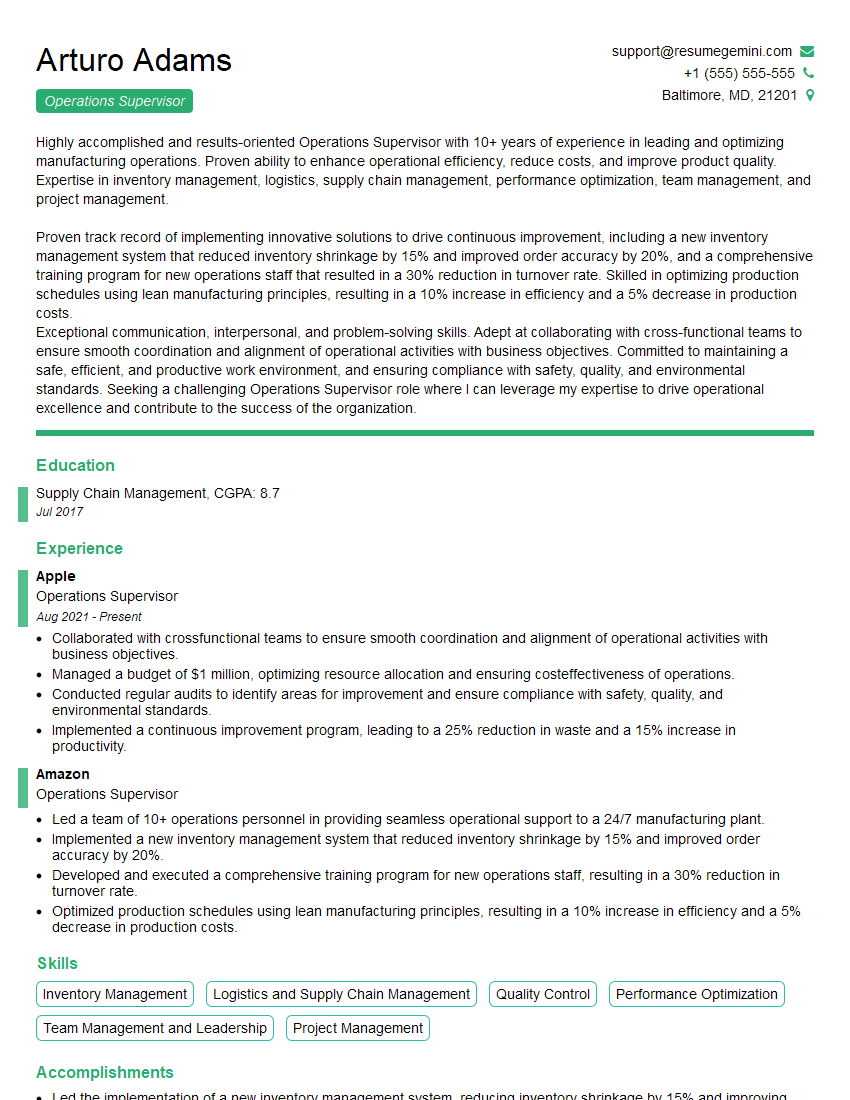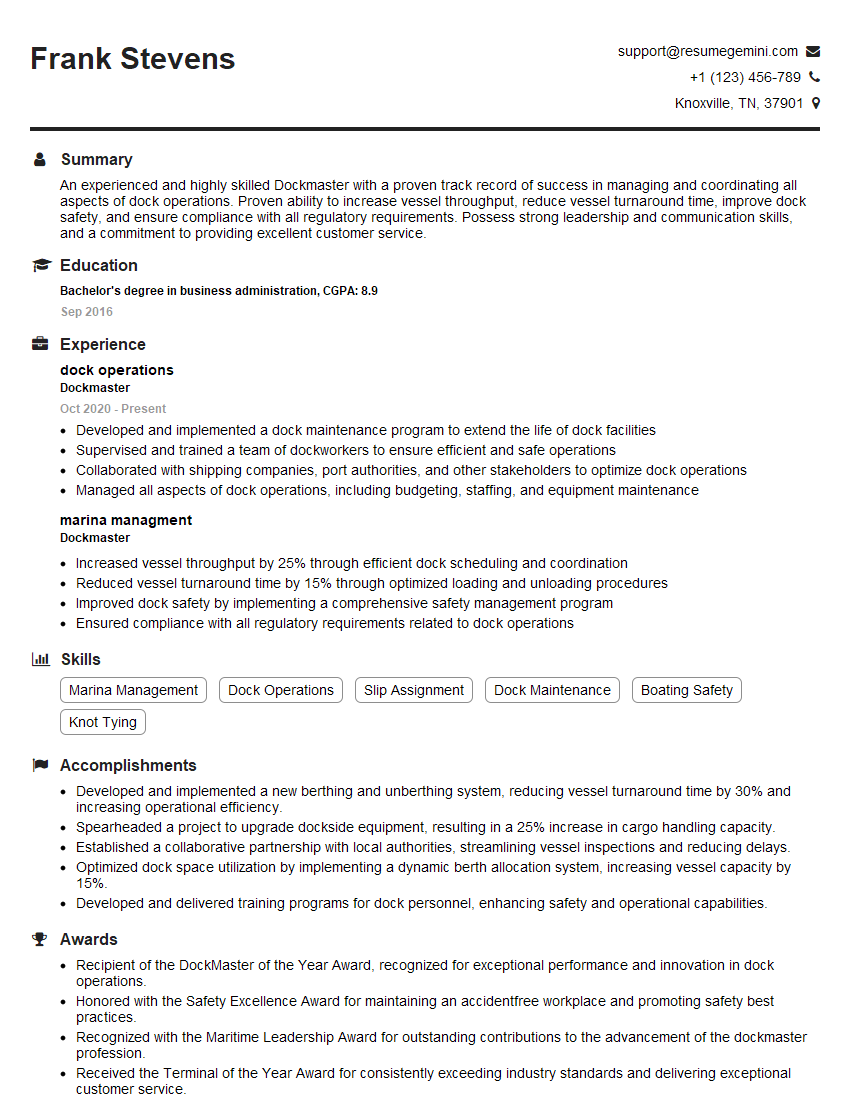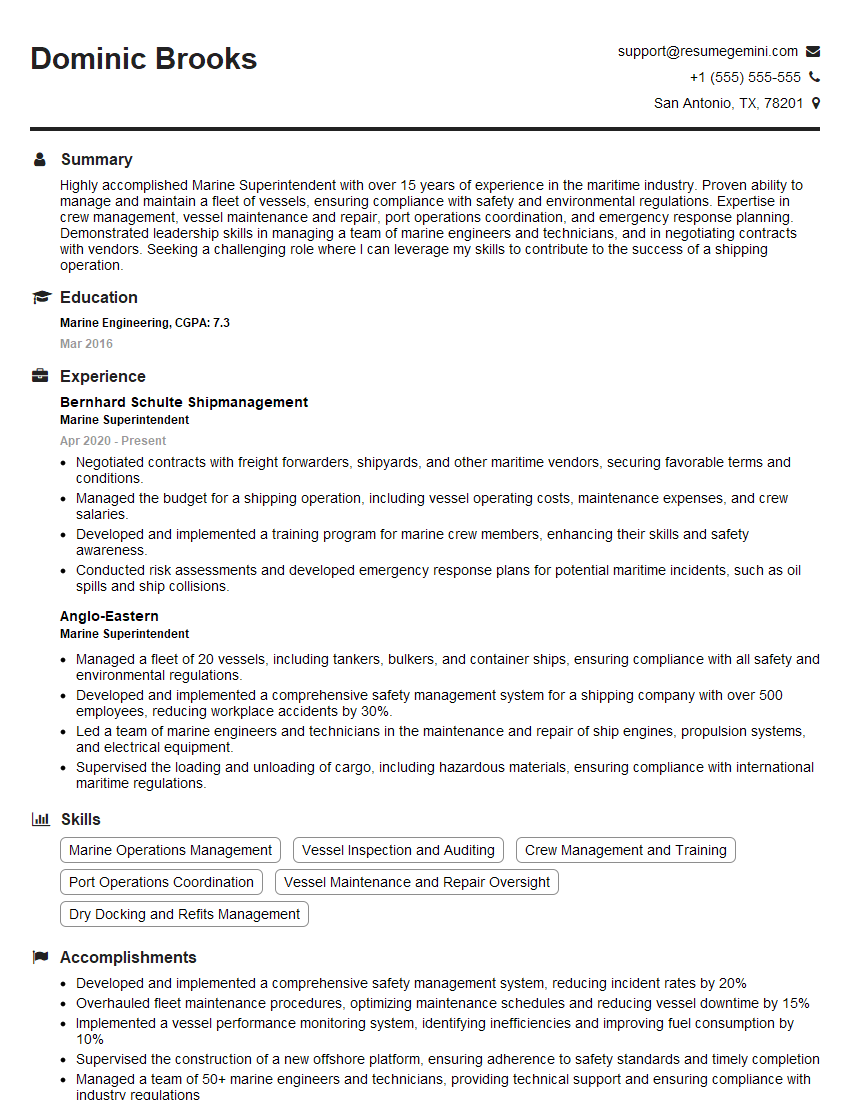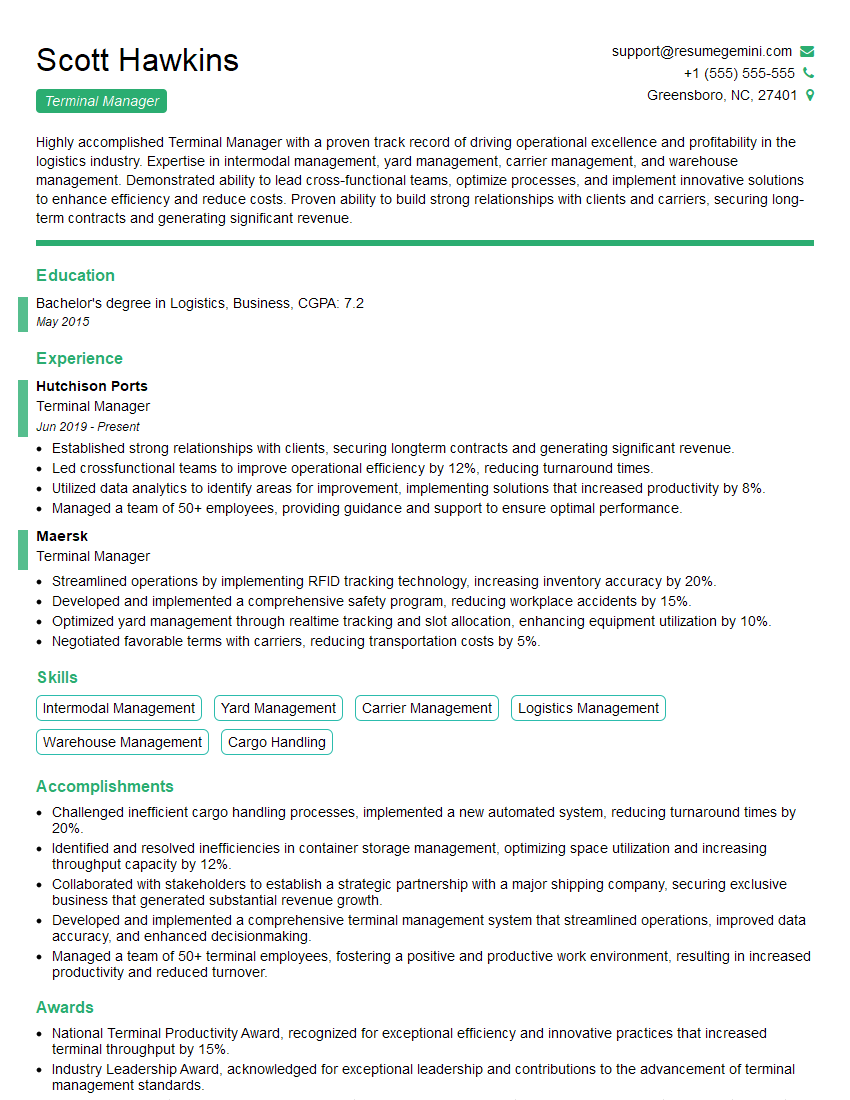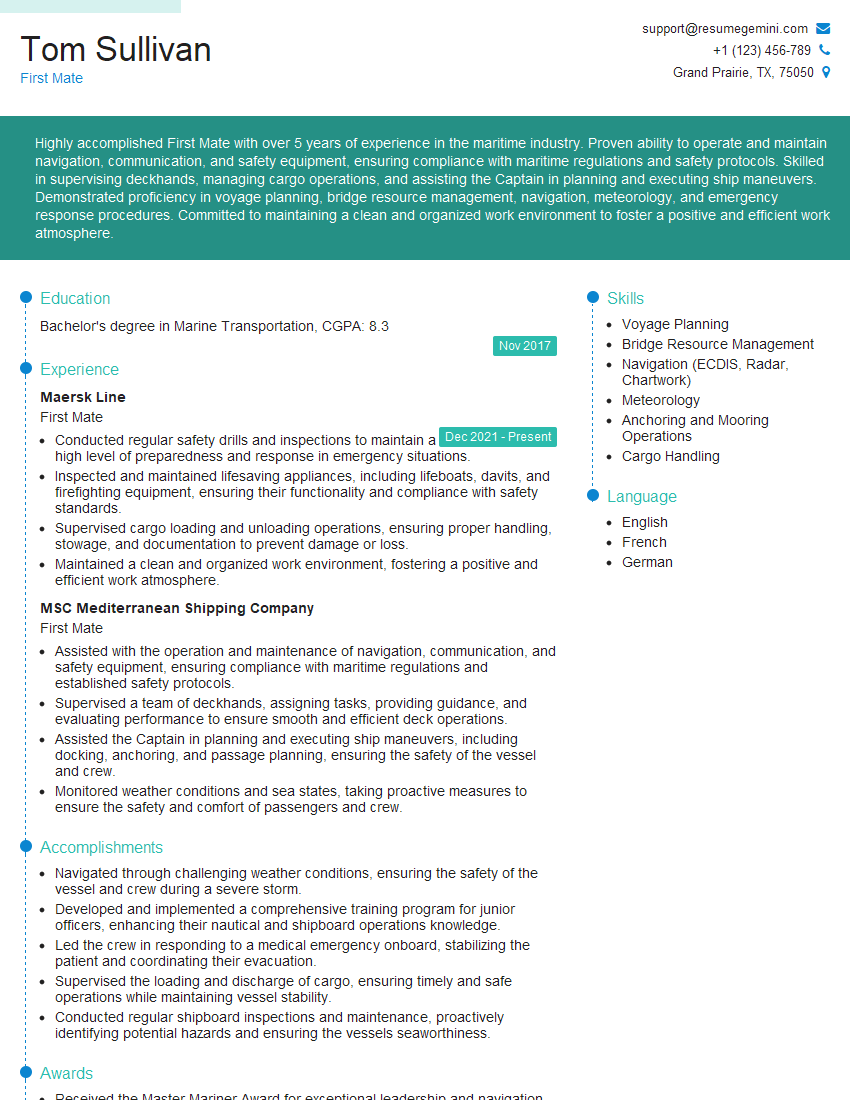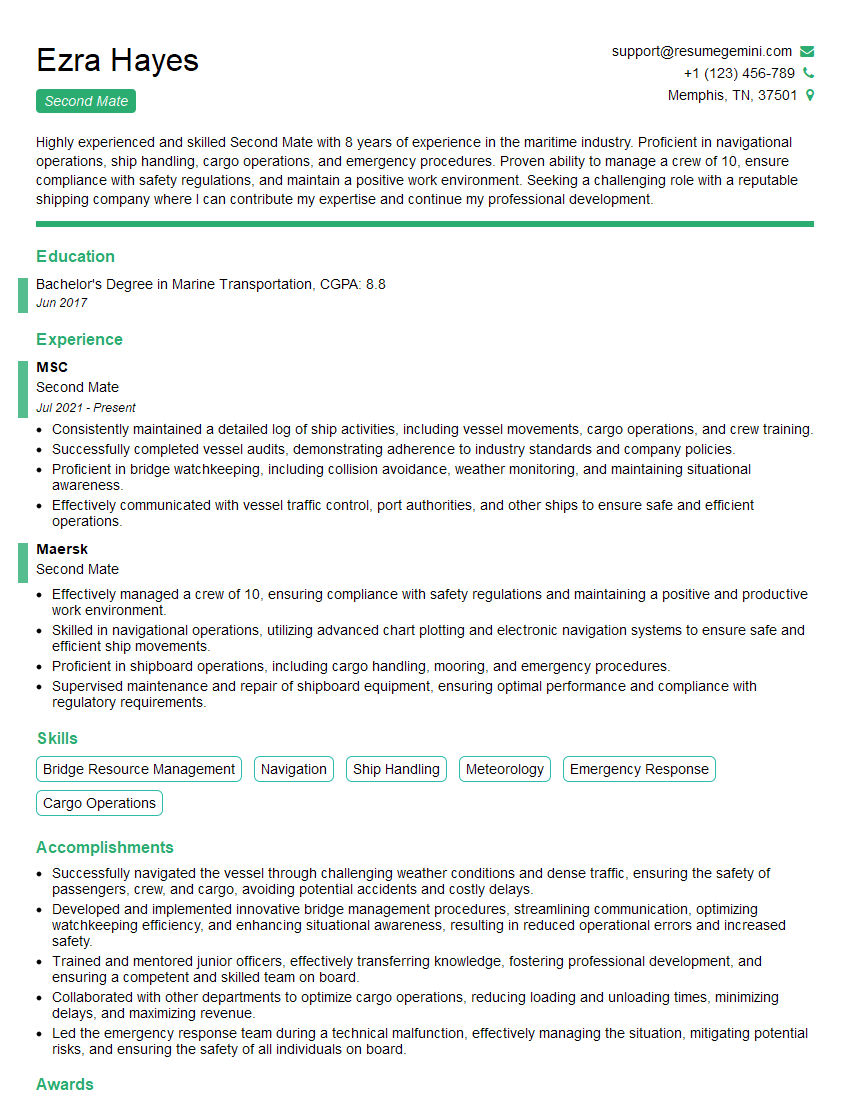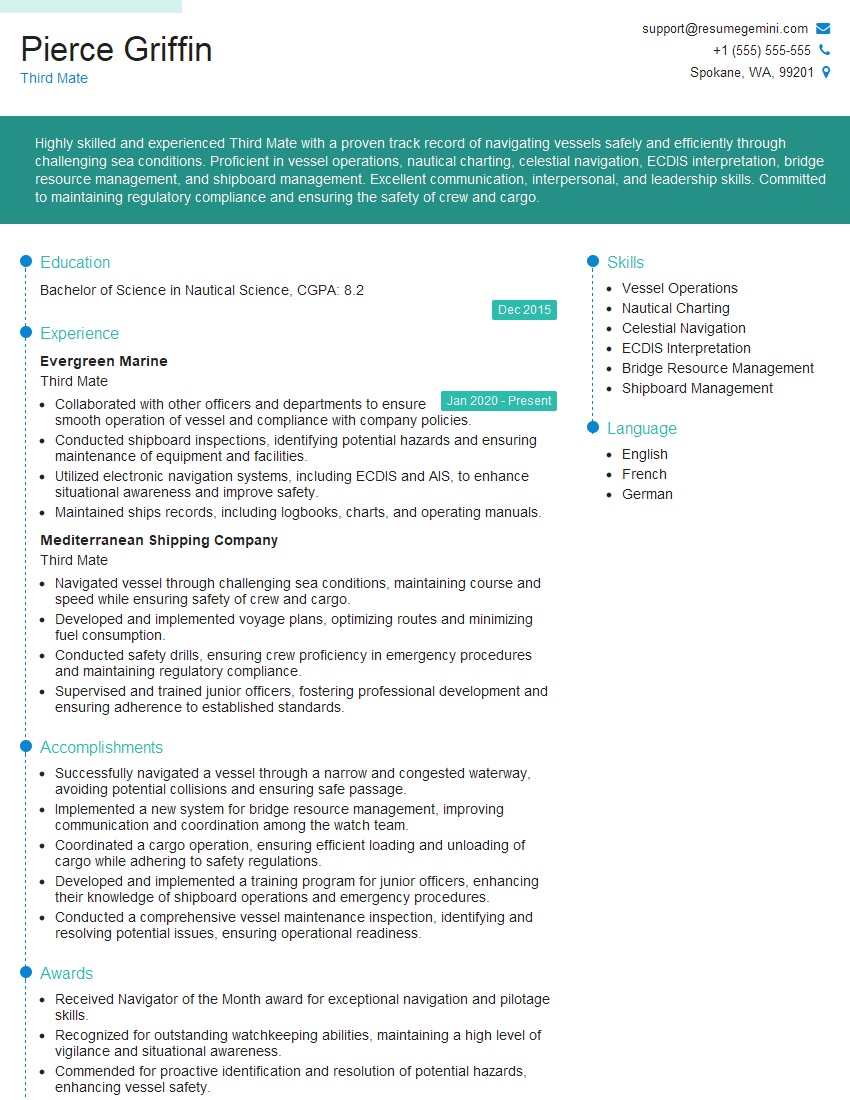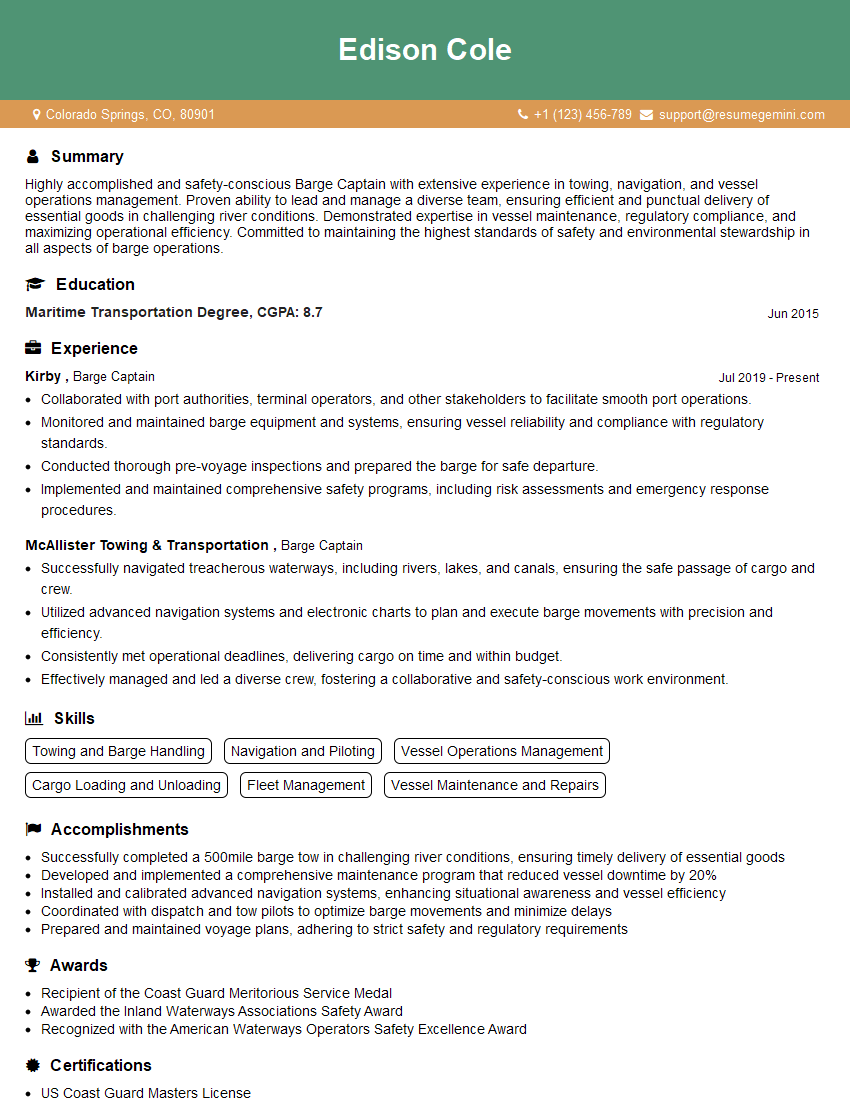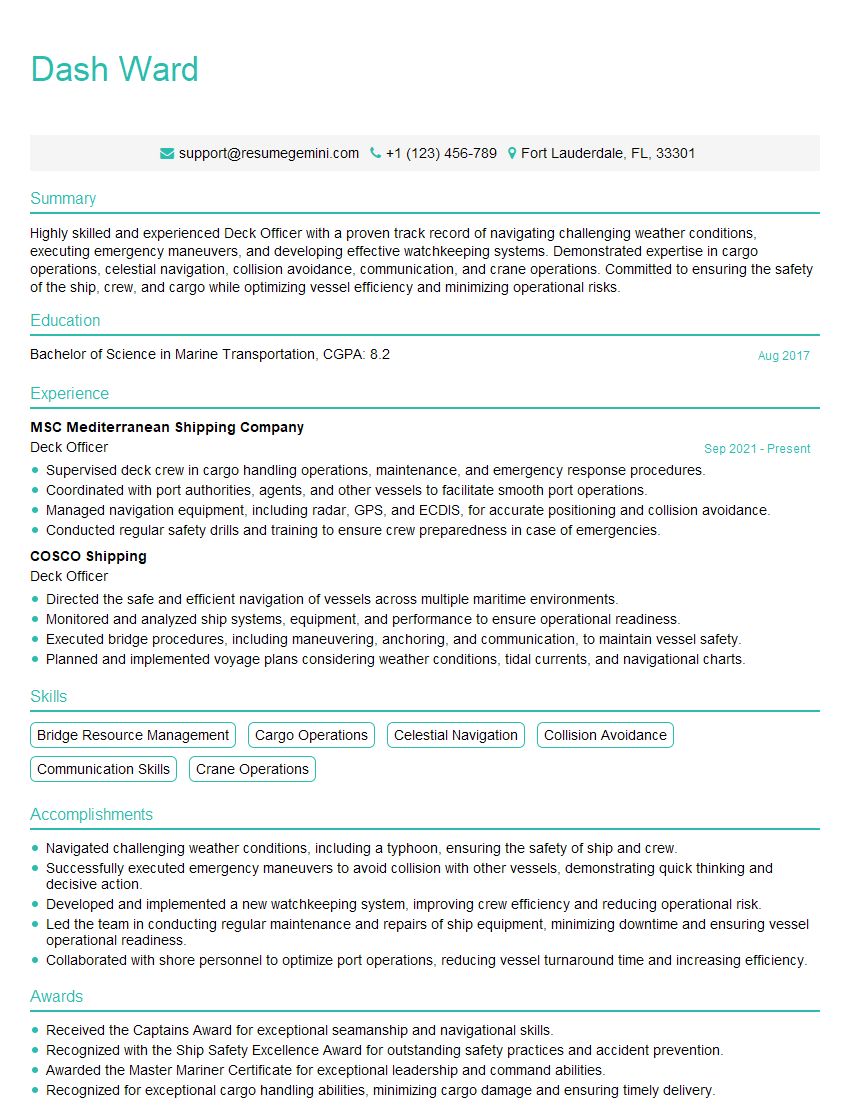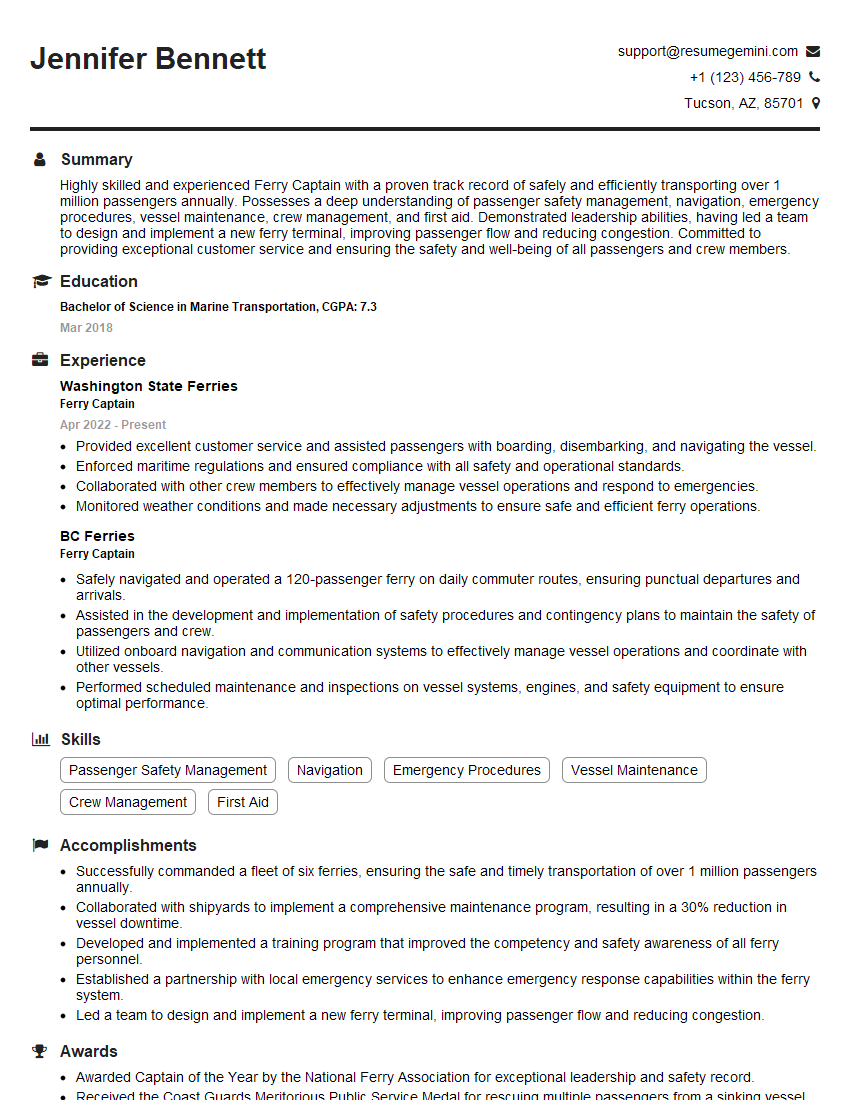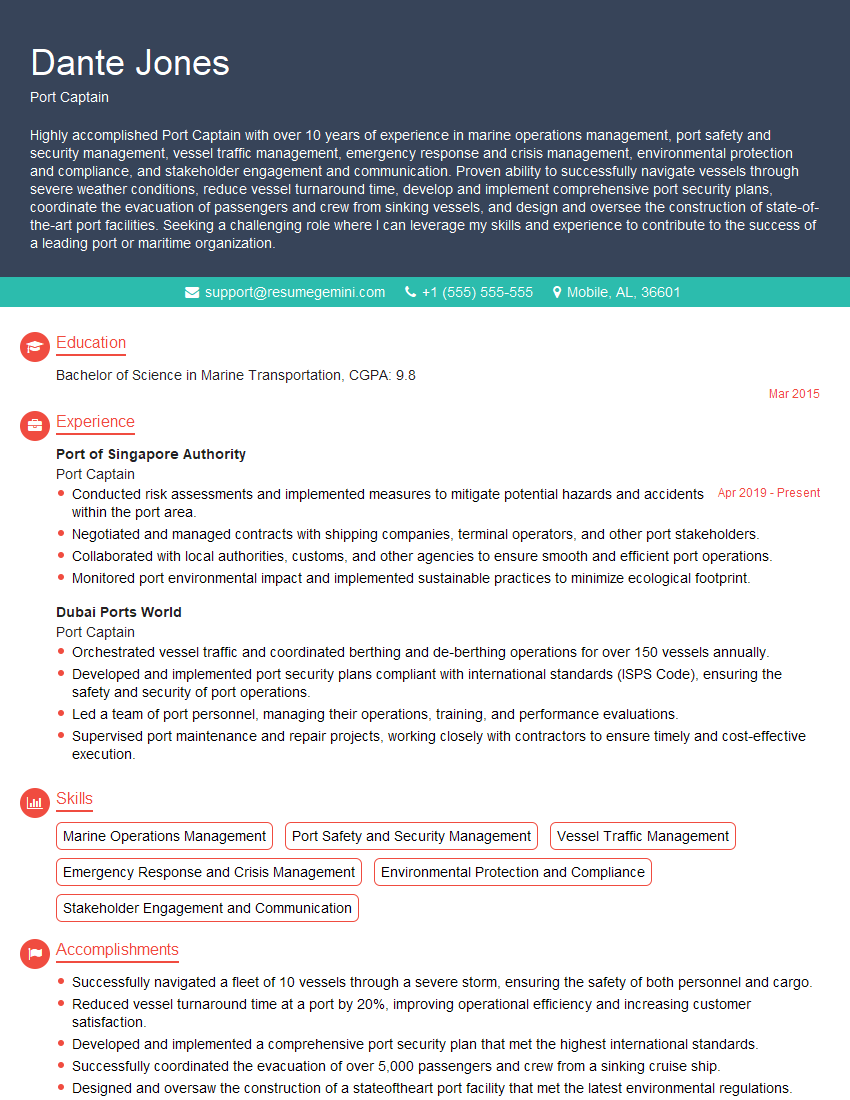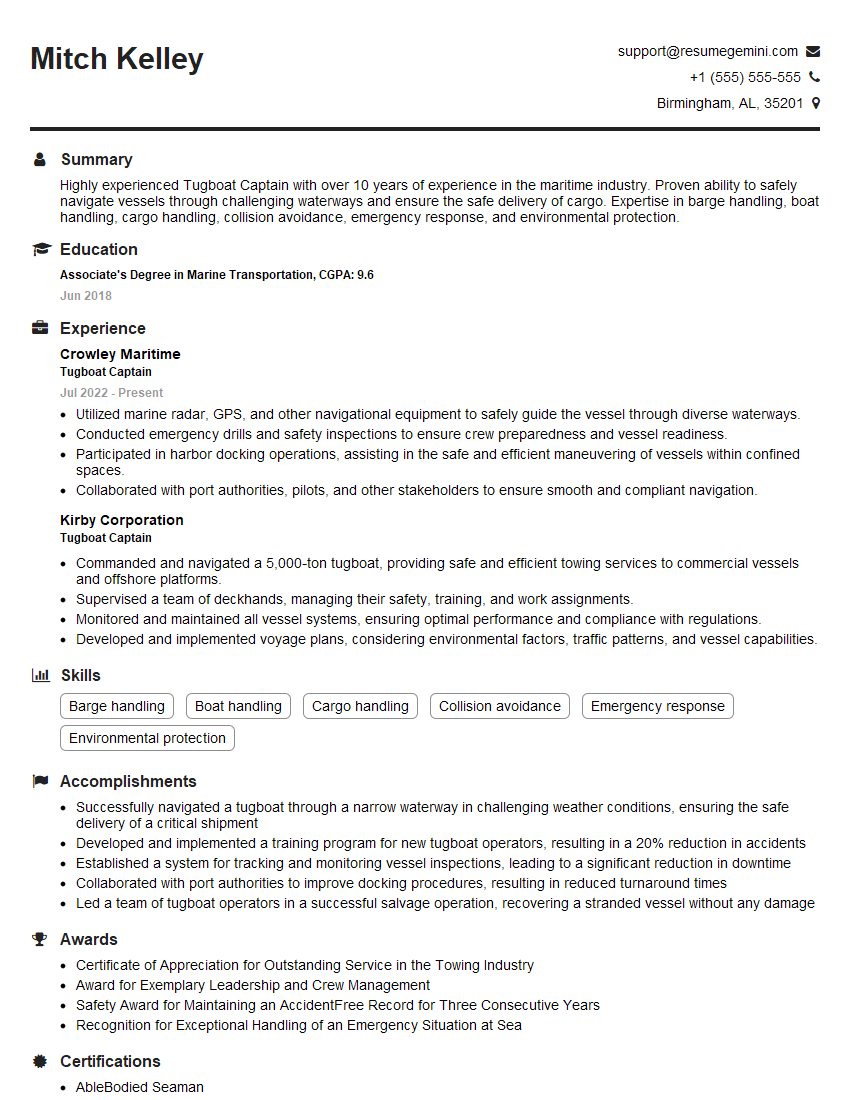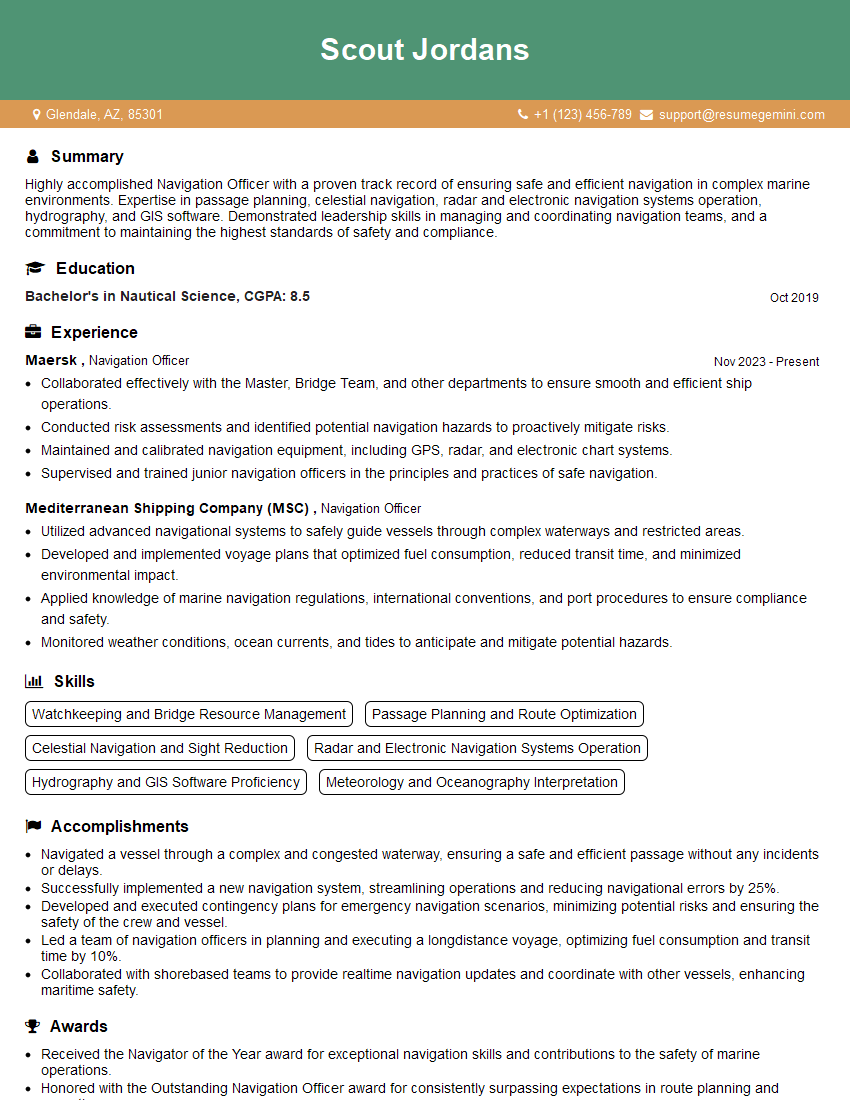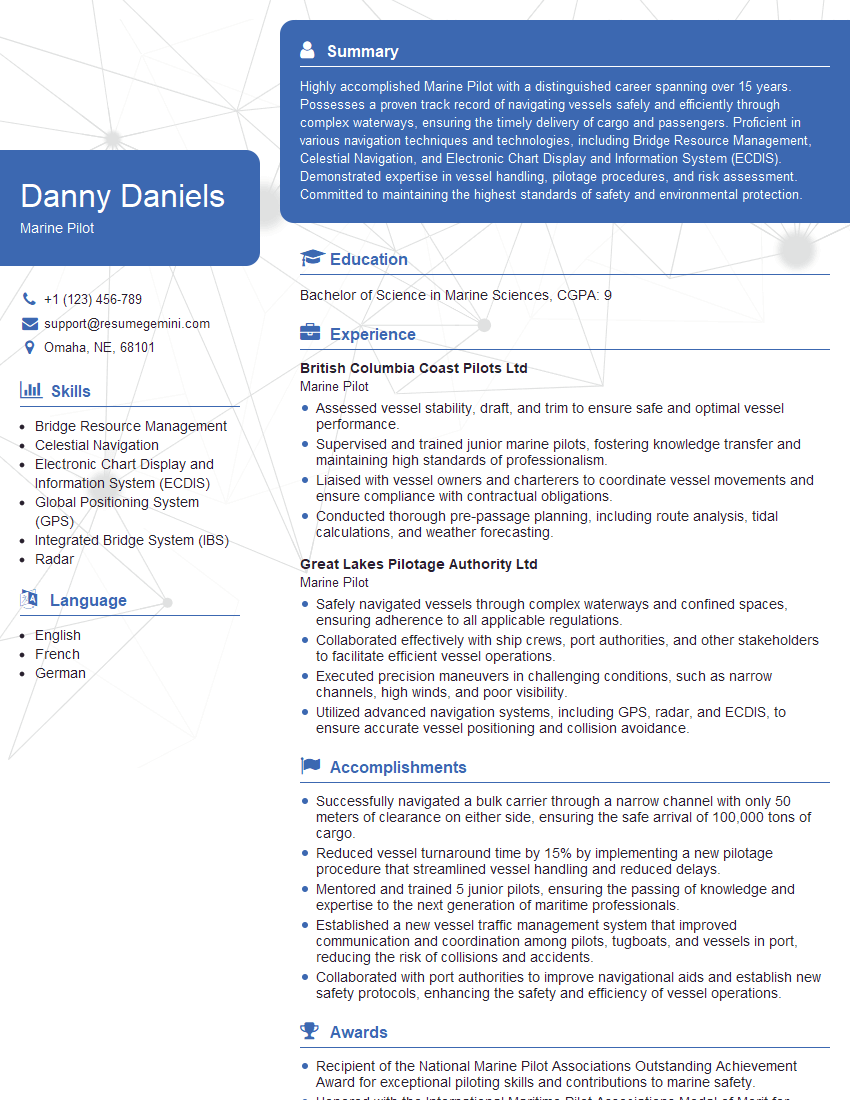Preparation is the key to success in any interview. In this post, we’ll explore crucial Anchoring and Docking interview questions and equip you with strategies to craft impactful answers. Whether you’re a beginner or a pro, these tips will elevate your preparation.
Questions Asked in Anchoring and Docking Interview
Q 1. Describe the different types of anchors and their applications.
Anchors are critical for securing a vessel in place. Different anchors are designed for various seabed conditions and vessel sizes. Here are some common types:
- Fluke Anchors (e.g., Danforth, Bruce): These are popular for their holding power in sand and mud. The fluke design digs into the seabed, providing strong grip. Danforths are lightweight and good for smaller boats, while Bruces are more robust and suitable for larger vessels.
- Plow Anchors (e.g., CQR, Delta): Known for their excellent holding power in various substrates, including rock and weed. Their shape allows them to reset themselves if dragged. CQR anchors are particularly popular for their holding power and ease of setting.
- Mushroom Anchors:
- These are typically used in sheltered areas with soft bottoms. Their large surface area provides stability but they lack the holding power of fluke or plow anchors in challenging conditions.
- Grappling Anchors:
- These anchors are designed to grab onto rocks or other obstructions. They are useful in emergency situations or when specific holding points are available. They are not suitable for soft seabed.
The choice of anchor depends on factors such as vessel size, seabed type, and expected weather conditions. For instance, a small sailboat might use a Danforth anchor in a sandy bay, while a large yacht might employ a plow anchor in a rocky anchorage.
Q 2. Explain the process of anchoring in various weather conditions.
Anchoring in varying weather conditions requires careful planning and execution. The key is to have sufficient scope (the length of anchor rode – rope or chain – paid out) to absorb the forces of wind and current.
- Calm Conditions: In calm weather, a lower scope (typically 5:1 – 7:1) might suffice. This means five to seven times the depth of water in anchor rode paid out.
- Moderate Conditions: With moderate winds and currents, increase the scope to 7:1 – 10:1 to provide a larger margin of safety. Consider using a longer rode or heavier anchor.
- Strong Winds and Currents: In severe conditions, a scope of 10:1 or even greater might be necessary. It’s vital to monitor the anchor’s holding power and be prepared to move to a more sheltered location if needed. Consider using a second anchor (a stern anchor) to increase security.
Always check the weather forecast before anchoring and be prepared to adjust your position or weigh anchor if conditions deteriorate. Remember, a good understanding of tides and currents is essential for safe anchoring.
Q 3. How do you determine the appropriate anchor scope?
Anchor scope is crucial for safe anchoring. It’s the ratio of anchor rode (chain and/or rope) paid out to the depth of water. Determining the appropriate scope involves several factors:
- Water Depth:
- Measure the depth of water where you intend to anchor.
- Seabed Type:
- A soft seabed (sand, mud) will require less scope than a hard seabed (rock, coral). Hard bottoms offer less shock absorption and increase risk of dragging.
- Weather Conditions:
- Higher winds and currents necessitate greater scope to absorb the forces exerted on the anchor and vessel.
- Vessel Size and Weight:
- Larger vessels require greater scope to prevent dragging.
- Tide and Current:
- Consider the effect of tides and currents on the anchor’s holding position and angle. Account for their potential to cause swing.
A general rule of thumb is to use a scope of at least 5:1 in calm conditions and up to 10:1 or more in strong winds or currents. Always err on the side of caution – extra scope is better than insufficient scope.
Q 4. What are the safety precautions involved in anchoring operations?
Safety is paramount during anchoring operations. Here are some key precautions:
- Thorough Inspection:
- Before anchoring, inspect all equipment (anchor, rode, windlass) for any damage or wear and tear.
- Proper Communication:
- Clearly communicate your intentions to anyone onboard and any nearby vessels.
- Check Seabed:
- Use depth sounder and charts to identify suitable anchorage free from obstructions or hazards.
- Observe Surrounding Vessels:
- Maintain a safe distance from other vessels in the anchorage.
- Emergency Preparedness:
- Have a plan in place in case the anchor drags or fails. Be prepared to deploy a second anchor or motor to a safer location.
- Watch for changes in weather:
- Stay aware of any changing weather conditions that could affect the anchorage.
Following these precautions greatly enhances safety. Remember to always prioritize safety over speed or convenience when anchoring.
Q 5. Describe the process of weighing anchor.
Weighing anchor, or retrieving the anchor, is the reverse of setting it. Here’s a step-by-step process:
- Check the rode:
- Ensure the anchor rode is clear of any obstructions.
- Engage the windlass (or manually heave):
- Begin hoisting the anchor slowly and steadily.
- Monitor the rode:
- Keep an eye on the anchor and rode for any snags or problems.
- Clear the anchor:
- Once the anchor is clear of the seabed, stow it securely.
- Secure the rode:
- Coil or properly stow the rode to prevent tangling.
During the process, always maintain control and be aware of your surroundings. If you encounter any difficulties, don’t hesitate to seek assistance.
Q 6. Explain the different methods of docking a vessel.
Docking a vessel safely requires skill and practice. Different methods are used depending on the vessel, harbor conditions, and available assistance. Here are some common methods:
- Spring Line Docking:
- This method involves using spring lines (lines running from the bow or stern to a cleat on the dock) to control the vessel’s movement sideways. It’s very useful in controlling the lateral movement of the vessel.
- Stern-to Docking:
- Approaching the dock stern-first allows for better control when maneuvering in tight spaces. Requires good use of engines and fenders.
- Bow-to Docking:
- Approaching the dock bow-first is often simpler in open areas with less emphasis on precision control.
- Med-Mooring:
- This is usually done with two anchors and lines from both sides of the vessel which are secured on the harbor. It is generally more suitable for calm conditions.
Each method requires a good understanding of boat handling, wind and current effects, and proper use of fenders and lines.
Q 7. How do you handle docking in strong currents or winds?
Docking in strong currents or winds presents challenges. Here’s how to handle them:
- Increased Awareness:
- Be even more aware of your surroundings and the vessel’s response to wind and current.
- Extra Lines and Fenders:
- Use extra lines (e.g., extra spring lines, breast lines) and fenders for added protection and control.
- Adjust Approach Speed:
- Adjust your approach speed to compensate for the effects of wind and current. You might need a slower approach than usual.
- Use of Engines:
- Use the engines effectively to counteract the wind and current. Small bursts of reverse thrust can be crucial.
- Dockhand Assistance:
- Seek assistance from dockhands or experienced crew members if available.
Practice and experience are key to mastering docking in challenging conditions. Always prioritize safety and never attempt a docking maneuver if you are unsure of your ability to handle it safely.
Q 8. What are the challenges of docking in confined spaces?
Docking in confined spaces presents numerous challenges due to the limited maneuverability and proximity to other vessels or structures. The biggest challenge is maintaining control of the vessel while minimizing the risk of collision. Factors such as strong currents, wind, and the vessel’s own momentum become significantly amplified in these environments.
- Reduced Maneuvering Room: Limited space restricts the use of large turning circles, necessitating precise engine control and potentially requiring tug assistance.
- Increased Risk of Collision: The close proximity of other vessels or structures greatly increases the likelihood of accidental contact, leading to potential damage or injury.
- Environmental Factors: Wind and currents can exert disproportionate influence in confined areas, making it harder to maintain desired heading and speed. These factors are especially problematic in narrow channels or alongside berths where water flow is constricted.
- Visibility Limitations: In some confined spaces, visibility might be limited due to obstructions, making accurate maneuvering even more challenging.
For example, docking a large cruise ship in a busy port during high winds requires exceptional skill and coordination, often involving multiple tugboats and precise communication between the captain, crew, and harbor pilots.
Q 9. What is the importance of communication during docking procedures?
Clear and effective communication is paramount during docking procedures, acting as the backbone for a safe and efficient operation. It ensures everyone involved understands the plan and any necessary adjustments in real-time. Miscommunication can lead to accidents, delays, and damage.
- Coordination Between Crew Members: Seamless communication between the captain, helmsman, deckhands handling lines, and anyone responsible for engine control is essential for synchronized maneuvers.
- Communication with External Parties: This includes harbor pilots, tugboat operators, and other vessels in the vicinity. Clear instructions and confirmations are crucial to avoid conflicts and ensure everyone is aware of the ship’s movements.
- Use of Standardized Terminology: Employing clear, concise, and universally understood nautical terms minimizes ambiguity and confusion. This is especially vital in high-pressure situations.
- Real-time Feedback: Continuous feedback on the vessel’s position, speed, and heading, relayed promptly via radio or other communication systems, allows for immediate adjustments and prevents potentially hazardous situations.
Imagine a situation where the captain orders ‘stop engines’, but the engine room misunderstands and continues at full speed. This could result in a collision. Clear, unambiguous communication prevents such scenarios.
Q 10. Describe the use of fenders and their placement during docking.
Fenders are essential protective devices placed along the hull of a vessel to absorb impact and reduce damage during docking or berthing. They act as a cushion between the vessel and the dock, jetty, or another vessel.
- Placement: Fenders are strategically positioned at points of likely contact during docking, typically at the bow, stern, and along the sides of the hull. Their placement depends on the vessel’s design, the docking location, and the expected angle of approach.
- Types of Fenders: Various fender types exist, such as cylindrical, rectangular, and inflatable fenders, each suitable for different applications. The choice of fender depends on the impact energy expected.
- Material: Most fenders are made of rubber or polyurethane due to their resilience, shock-absorbing properties, and ability to withstand wear and tear.
- Number and Size: The number and size of fenders required vary greatly depending on the size and type of vessel, and the forces expected during docking.
For instance, a larger vessel docking alongside a quay would require a greater number and larger size of fenders compared to a smaller boat tying up to a pier. Incorrect fender placement, especially in confined spaces, can lead to damage to the vessel or the structure.
Q 11. Explain the role of mooring lines in securing a vessel.
Mooring lines are the ropes or cables used to secure a vessel to a dock, jetty, or an anchor. They are crucial for maintaining the vessel’s position and preventing it from drifting or moving unexpectedly. Their role extends beyond simply holding the vessel; they also assist in controlling its movement during docking and undocking.
- Types of Mooring Lines: Different types of lines are used depending on the strength required, including nylon, polyester, and wire rope. The choice depends on the vessel’s size, the expected forces, and the environment.
- Arrangement: Mooring lines are typically arranged in a specific pattern to distribute the load evenly and provide optimal control. This often involves a combination of forward and aft lines, as well as spring lines to control lateral movement.
- Securing Techniques: Lines are secured using various knots and hitches, chosen for their strength and ease of adjustment. Proper knotting is crucial to prevent lines from slipping or breaking under load.
Think of mooring lines as the ‘safety net’ for a vessel. Without them, even on a calm day, a vessel could easily drift away from the desired location. Improper use could lead to damage or even loss of the vessel.
Q 12. How do you manage the tension on mooring lines?
Managing tension on mooring lines is critical for preventing damage to the lines, the vessel, and the dock. Over-tensioning can cause lines to snap, while under-tensioning can allow the vessel to drift. Proper tension is achieved through a combination of techniques.
- Use of Belaying Pins: Lines are secured to bollards or cleats using belaying pins, which allow for controlled adjustment of the tension. Lines should never be wrapped directly around a bollard without a pin.
- Controlled Letting Out and Taking In: Adjusting the tension involves carefully paying out or hauling in lines to match the vessel’s movements and environmental conditions.
- Use of Line-Handling Equipment: Winches or capstans can be used to assist with managing the tension on larger lines, especially in challenging conditions.
- Regular Inspections: Lines should be frequently inspected for signs of wear or damage. Lines showing signs of wear should be replaced immediately.
Think of a tug-of-war; too much tension on one side, and the rope breaks. Too little, and you lose the game. Similarly, proper tension in mooring lines is a balance, needing skilled judgement and experience.
Q 13. What are the signs of a failing mooring line?
Recognizing signs of a failing mooring line is crucial for preventing accidents. Regular inspection is key, but some tell-tale signs include:
- Chafing: Wear and tear caused by friction against other lines, bollards, or the vessel’s hull.
- Kinking or Twisting: Lines that are severely kinked or twisted are weakened and more prone to breaking.
- Fraying or Broken Strands: Visible fraying or broken fibers in the line indicate significant weakening and a high risk of failure.
- Unusual Stretching or Elongation: Excessive stretching beyond the line’s normal elasticity suggests possible internal damage.
- Swelling or Softening: In some materials, changes in the line’s texture or consistency might indicate deterioration.
Ignoring these signs can lead to catastrophic failures, potentially resulting in damage to the vessel or the dock, or even injuries to personnel. A weak line, under tension, might suddenly snap, causing uncontrolled vessel movement.
Q 14. How do you handle an emergency situation during docking?
Emergency situations during docking can range from minor snags to serious collisions. A swift and coordinated response is essential. The first step is to assess the situation and determine the immediate threat.
- Prioritize Safety: The primary goal is to ensure the safety of crew, passengers, and anyone in the vicinity. This may involve evacuating personnel if necessary.
- Control Vessel Movement: Immediate actions should focus on regaining control of the vessel. This might involve using engines, anchors, or tugboats to stop or slow the vessel.
- Damage Control: Assess any damage to the vessel or other structures and implement necessary damage-control measures. This could involve using pumps to remove water or securing damaged areas.
- Communication: Maintain clear and concise communication with the harbor authorities, other vessels, and relevant emergency services.
- Post-Incident Report: Thorough documentation of the incident is crucial, detailing the events, causes, and resulting damage. This information is critical for future risk mitigation.
A classic example is a sudden engine failure during docking. The immediate response would involve using other means to control the vessel’s movement, possibly utilizing tugboats or deploying anchors, while simultaneously contacting the harbor authorities and seeking assistance.
Q 15. What are the international regulations governing anchoring and docking?
International regulations governing anchoring and docking are multifaceted and depend heavily on the vessel type, location, and the specific governing body (e.g., IMO, national maritime authorities, port regulations). They generally cover safety, environmental protection, and the prevention of collisions.
- SOLAS (Safety of Life at Sea): Addresses many safety aspects related to anchoring and mooring equipment, including the condition and maintenance of anchors, chains, and mooring lines.
- MARPOL (International Convention for the Prevention of Pollution from Ships): Dictates regulations concerning the prevention of pollution from operational discharges during anchoring and docking, for instance, preventing oil spills.
- Port State Control: Authorities in each port have the power to inspect vessels and ensure compliance with various international and national regulations related to anchoring and docking practices. Non-compliance can lead to detention.
- National and Local Regulations: Individual countries and port authorities have specific regulations related to anchoring zones, speed limits within port areas, and procedures for docking and undocking.
These regulations often involve detailed procedures, including pre-arrival notifications, pilot use requirements in certain areas, and communication protocols between the vessel, port authorities, and other vessels.
Career Expert Tips:
- Ace those interviews! Prepare effectively by reviewing the Top 50 Most Common Interview Questions on ResumeGemini.
- Navigate your job search with confidence! Explore a wide range of Career Tips on ResumeGemini. Learn about common challenges and recommendations to overcome them.
- Craft the perfect resume! Master the Art of Resume Writing with ResumeGemini’s guide. Showcase your unique qualifications and achievements effectively.
- Don’t miss out on holiday savings! Build your dream resume with ResumeGemini’s ATS optimized templates.
Q 16. Explain the use of a mooring buoy.
A mooring buoy is a floating marker secured to the seabed with a strong anchor and chain. It’s used as a convenient and safe way to moor a vessel. Instead of dropping anchor each time, vessels can simply attach themselves to the buoy. This is especially useful in areas with limited space or challenging seabed conditions.
- Ease of use: Simplifies the mooring process, especially for smaller vessels or those without sophisticated anchoring equipment.
- Reduced risk of damage: Minimizes the risk of damage to the seabed and reduces the effort involved in anchoring and weighing anchor.
- Designated mooring areas: Helps regulate the use of anchoring areas and prevents overcrowding.
- Improved safety: Provides a designated and secure point for vessels to moor, particularly during adverse weather conditions.
Imagine a busy marina; mooring buoys allow efficient and organized mooring, avoiding collisions and chaotic anchoring.
Q 17. Describe the procedure for securing a vessel alongside a pier.
Securing a vessel alongside a pier involves a careful and coordinated process, and should never be undertaken without proper planning and communication.
- Approach and Preparation: The vessel approaches the pier at a slow speed, taking into account wind, current, and the proximity of other vessels. The appropriate fenders (protective rubber devices) and mooring lines are prepared and readily available.
- Initial Contact: A mooring line (typically the forward spring line) is passed ashore to a dockhand or a dedicated mooring facility. The vessel gradually slows, using engines to control speed and avoid momentum.
- Securing Mooring Lines: Other mooring lines – stern lines, aft spring lines – are secured to appropriate bollards (posts on the pier) to control the vessel’s position. The lines are usually paid out gradually, ensuring a proper tension to keep the vessel securely alongside.
- Final Adjustments: Once securely alongside, the vessel’s position is fine-tuned to avoid rubbing against the pier. Any needed adjustments are made to the mooring lines. Engines may be used for minor adjustments.
- Communication: Constant and clear communication between the bridge, the dockhands, and anyone else involved is absolutely critical throughout the process.
Consider this as a precise ballet where even a slight mistake could lead to damage to the vessel or pier. Proper teamwork and experience are key to success.
Q 18. How do you assess the risk associated with anchoring and docking?
Assessing risk in anchoring and docking involves considering a multitude of factors which can often be summarized using a risk assessment matrix.
- Environmental Conditions: Wind speed and direction, current strength and direction, sea state (wave height and period), visibility, and tidal conditions are all crucial. Strong winds and currents increase the difficulty and risk.
- Vessel Characteristics: The vessel’s size, maneuverability, draft (depth below the waterline), and the condition of its anchoring and mooring equipment are critical factors. A large vessel requires more space and careful planning.
- Port/Location Specifics: The depth of water, the type of seabed, the presence of obstructions (other vessels, underwater hazards), the availability of mooring facilities, and the local port regulations significantly impact the risk assessment.
- Human Factors: The experience and competence of the crew, the effectiveness of communication, and the availability of navigational aids all play a part. Fatigue and lack of adequate training significantly increase risk.
Each of these factors should be assessed, and a mitigation strategy developed to minimise associated risks. This might involve using tugs, having extra crew members available, or postponing the operation until conditions improve.
Q 19. What is the role of the bridge team during anchoring and docking?
The bridge team plays a central role in coordinating all aspects of anchoring and docking operations.
- Navigation: The officer of the watch (OOW) ensures safe navigation to the designated anchoring or docking position, using charts, radar, GPS, and other navigational aids.
- Communication: The OOW maintains constant communication with port authorities, pilots (if used), tugs, and dockhands, ensuring a smooth and coordinated operation.
- Maneuvering: The master (or OOW) skillfully uses the vessel’s engines and other control systems to accurately position the vessel, while responding to changes in environmental conditions.
- Mooring Operations: Supervises the crew during mooring operations, ensuring the safe and secure handling of mooring lines, fenders, and other equipment.
- Risk Assessment and Management: The bridge team continuously monitors the situation, assesses potential risks, and implements mitigating actions as needed.
The bridge team’s expertise and coordinated actions are critical for a successful and safe anchoring or docking operation.
Q 20. Explain the use of tugs during docking procedures.
Tugs are powerful vessels used to assist larger ships during docking and undocking maneuvers, especially in challenging conditions. They offer significant advantages in terms of enhanced safety and control.
- Increased Maneuverability: Tugs provide extra power to assist in controlling a vessel’s position, speed, and heading. This is particularly helpful in confined spaces or strong currents.
- Improved Safety: By reducing the vessel’s momentum, tugs significantly reduce the risk of collisions or damage to the vessel or harbor structures.
- Difficult Conditions: They are essential for docking large vessels in adverse weather, strong currents, or narrow channels.
- Emergency Assistance: Tugs can provide immediate assistance in emergency situations, such as loss of propulsion or steering failure.
Imagine trying to park a large truck in a tight space – a tugboat is like having a very powerful helper assisting in the precision maneuvering needed.
Q 21. How do you handle a situation where the vessel is drifting during docking?
If a vessel is drifting during docking, immediate and decisive action is required to prevent an accident. The priority is to regain control and safely secure the vessel.
- Assess the Situation: Quickly determine the cause of the drift (e.g., engine failure, strong currents, inadequate mooring lines).
Rapid assessment, effective communication, and skillful use of available resources are critical in handling this type of emergency.
Q 22. Describe your experience with different types of docking systems.
My experience encompasses a wide range of docking systems, from simple spring lines and fenders used for smaller vessels in sheltered harbors to sophisticated automated mooring systems employed by large cruise ships and offshore platforms. I’ve worked with various types of mooring lines, including nylon, polyester, and wire rope, each with its own strengths and weaknesses concerning elasticity, strength, and abrasion resistance. I’m also familiar with different docking aids such as hydraulically powered winches, remote-controlled bollards, and automated docking systems which utilize GPS and sensor data to assist the docking process. For example, while working on a container ship, I gained extensive hands-on experience with the ship’s sophisticated mooring system, encompassing multiple winches, capstans, and a complex arrangement of mooring lines for efficient and safe berthing in varied weather conditions. In smaller-scale operations, I’ve used simpler systems, emphasizing the importance of skilled crew coordination and precise manual operation.
- Spring Lines: Used to control fore and aft movement.
- Breast Lines: Used to control sideways movement.
- Head and Stern Lines: Secure the vessel to the dock.
- Automated Mooring Systems: Utilize sensors and automation for precise and efficient docking.
Q 23. What are the environmental considerations related to anchoring and docking?
Environmental considerations are paramount in anchoring and docking. We must prioritize minimizing the impact on marine ecosystems and preventing pollution. This includes careful selection of anchoring locations to avoid sensitive habitats like coral reefs or seagrass beds. The use of environmentally friendly materials in mooring lines and fenders is also crucial, and we must prevent the release of oil, grease, or other pollutants into the water. Proper waste management onboard is vital. For example, during a project in a sensitive coastal area, we implemented a detailed environmental impact assessment that informed the selection of the anchoring location and mooring equipment, ensuring minimal disturbance to the local marine life and habitat. We also employed environmentally friendly biodegradable fenders to further reduce impact.
- Habitat Protection: Avoiding damage to sensitive marine ecosystems.
- Pollution Prevention: Preventing the release of oil, grease, and other pollutants.
- Waste Management: Proper disposal of waste materials.
- Noise Pollution: Minimizing noise generated during docking procedures.
Q 24. How do you maintain the integrity of anchoring and mooring equipment?
Maintaining the integrity of anchoring and mooring equipment is crucial for safety and efficiency. This involves regular inspections for wear and tear, corrosion, and damage. We use visual inspections, non-destructive testing techniques such as ultrasonic testing for wire ropes, and meticulous record-keeping to track the condition of equipment. Regular maintenance includes lubrication, replacing worn parts promptly, and applying corrosion inhibitors to extend the life of the equipment. For example, I developed a detailed maintenance schedule for a fleet of barges, which included regular inspections of anchors, chains, and mooring lines, ensuring they were always fit for use and that potential problems were addressed before they escalated. This proactive approach minimizes the risk of equipment failure and ensures operational safety.
- Regular Inspections: Visual checks for wear and tear.
- Non-Destructive Testing: Techniques like ultrasonic testing for wire ropes.
- Maintenance and Repairs: Prompt replacement of worn parts.
- Record Keeping: Documentation of inspections and maintenance activities.
Q 25. Describe your experience using electronic navigation systems during docking.
Electronic navigation systems are indispensable during docking, significantly enhancing precision and safety. I’m proficient in using GPS, radar, Automatic Identification System (AIS), and Electronic Chart Display and Information Systems (ECDIS). These systems provide real-time information on vessel position, speed, course, surrounding vessels, and water depth, allowing for precise maneuvering during docking. For instance, during a challenging docking operation in a congested port, the use of AIS allowed us to monitor the movements of other vessels in real-time, preventing collisions. ECDIS provided precise details about water depths and underwater obstructions. My experience includes utilizing DP (Dynamic Positioning) systems on offshore installations, which further enhance the accuracy and safety of complex docking procedures.
- GPS: Real-time positioning information.
- Radar: Detecting obstacles and other vessels.
- AIS: Tracking the movements of other vessels.
- ECDIS: Detailed navigational charts and information.
- DP Systems: Automated control of vessel position and heading.
Q 26. How do you calculate the required number of mooring lines?
Calculating the required number of mooring lines depends on several factors, including vessel size, environmental conditions (wind, current, tide), and the characteristics of the dock and berth. There’s no single formula; it’s a judgment call based on experience and engineering principles. However, we consider the forces acting on the vessel and ensure sufficient lines are used to counteract these forces and maintain control. We usually consider redundancy; having more lines than the absolute minimum allows for some lines to fail without compromising the overall security. A risk assessment considering the factors I mentioned above is typically performed, informing this decision. For example, in high-wind conditions, we might use extra lines and increase their angle to the dock to enhance security. In calm conditions, fewer lines may suffice. Proper line tension is also critical and requires constant monitoring.
Q 27. Explain the importance of pre-docking planning.
Pre-docking planning is crucial for a safe and efficient docking operation. It involves assessing environmental conditions, confirming the available berthing space, verifying the condition of mooring equipment, and coordinating with port authorities and other vessels in the area. This planning minimizes potential risks and ensures that the process goes smoothly. A detailed plan should include the docking procedure, including the sequence of operations, assigned roles for crew members, and emergency response procedures. Thorough pre-planning drastically reduces the chances of accidents or delays, saving time, resources, and safeguarding the vessel and crew. A simple checklist for relevant factors is often used to ensure a complete and comprehensive plan is in place.
- Environmental Assessment: Wind, current, tide, and weather conditions.
- Berthing Space: Available space at the dock.
- Mooring Equipment: Condition and availability of mooring lines and equipment.
- Coordination: Communication with port authorities and other vessels.
- Emergency Procedures: Contingency plans for unexpected events.
Q 28. Describe a situation where you had to solve a challenging docking problem.
During a night docking operation in heavy fog, with strong crosswinds, we encountered a challenging situation. Visibility was severely limited, making the use of radar and AIS crucial. The strong winds made precise maneuvering extremely difficult. Using the vessel’s dynamic positioning system and coordinating closely with the tugboats, we successfully navigated the difficult conditions. The pre-docking planning and the effective communication between the bridge team and the tugboat captains proved pivotal. We carefully monitored the vessel’s position and adjusted the line handling as needed. We successfully completed the docking process safely and without incident, demonstrating the importance of teamwork, quick thinking, and reliance on technology in challenging conditions. This incident highlighted the need for careful preparation and effective crisis management strategies in complex docking operations.
Key Topics to Learn for Anchoring and Docking Interview
- Understanding Vessel Maneuvering: Theoretical principles of ship handling in various weather conditions and water depths, including the effects of wind, currents, and tides on vessel movement.
- Anchoring Techniques: Practical application of different anchoring techniques (e.g., single anchor, multiple anchors, emergency anchoring), including calculations for scope and holding power.
- Docking Procedures: Mastering various docking maneuvers (e.g., alongside, stern-to, bow-in), understanding the use of fenders, mooring lines, and tugs.
- Navigation and Chartwork: Interpreting nautical charts, understanding navigational aids, and applying this knowledge to safe anchoring and docking procedures.
- Safety Regulations and Procedures: Familiarity with international maritime regulations and safety protocols related to anchoring and docking operations, including emergency procedures.
- Communication and Teamwork: Effective communication with bridge personnel, tug masters, and other crew members during anchoring and docking operations.
- Problem-Solving and Decision-Making: Analyzing potential hazards and developing effective strategies for safe and efficient anchoring and docking in challenging situations.
- Equipment Knowledge: Familiarity with the operation and maintenance of anchoring and mooring equipment (e.g., windlasses, capstans, mooring winches).
- Environmental Considerations: Understanding the environmental impact of anchoring and docking operations and best practices for minimizing harm to the environment.
Next Steps
Mastering Anchoring and Docking is crucial for career advancement in the maritime industry, opening doors to more challenging and rewarding roles. A strong resume is your key to unlocking these opportunities. Creating an ATS-friendly resume ensures your qualifications are effectively communicated to potential employers. ResumeGemini can significantly enhance your resume-building experience, helping you craft a compelling document that showcases your skills and experience in Anchoring and Docking. Use ResumeGemini to create a professional and effective resume, and take advantage of the provided examples tailored to Anchoring and Docking roles. This will significantly improve your chances of landing your dream job.
Explore more articles
Users Rating of Our Blogs
Share Your Experience
We value your feedback! Please rate our content and share your thoughts (optional).
What Readers Say About Our Blog
Hi, I’m Jay, we have a few potential clients that are interested in your services, thought you might be a good fit. I’d love to talk about the details, when do you have time to talk?
Best,
Jay
Founder | CEO
